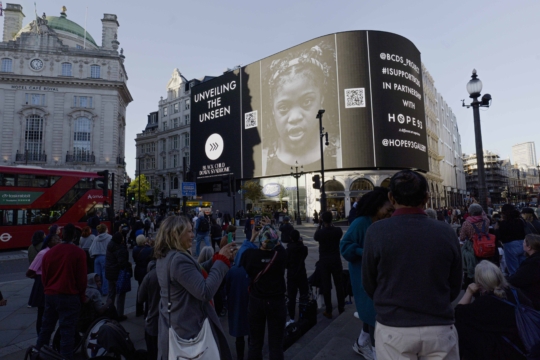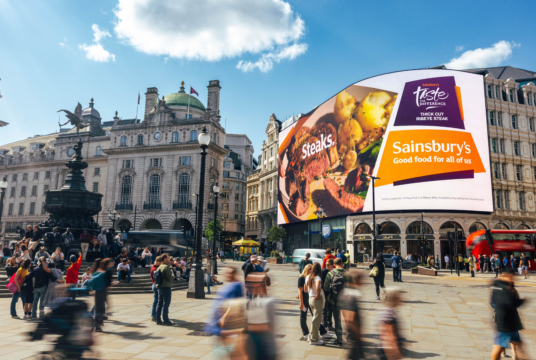
Ocean Labs MD Catherine Morgan and our Creative Director David Tait give their low down on the Las Vegas tech extravaganza CES 2024. Our latter day Jetsons walked 15 miles in search of the wonderful, the wacky and the downright weird.
Top takeaways
David: It was good to see the progression of transparent screens, especially seeing the technology move from OLED to micro LED. How we use transparent displays in OOH in order to broadcast disappearing content like scores, local updates and ads going forward could be a game changer.
There were Spheres of all sizes, from the insane creativity of the Vegas Sphere that stands 360 feet tall, all the way down to two metre wide spheres showing real time weather information. Screens of all shapes and sizes dominated and a lot of them were multi-layered, transparent large format to add more depth.
Catherine: Digital barriers. A bit random but turning analogue formats into digital screens was a thing. Mixing media in unusual spaces was an interesting, recurring theme and so very out of home. We also saw the latest from the 3D integrated holographic and other “hologram” style effects. The holograms didn’t seem to have moved forward apart from an AI overlay which made David look like Les Dennis.
A mention too for Google’s Geospatial technology which we used as part of the double Cannes Lions-winning Gorillaz ‘Skinny Ape’ collaboration. At the show, Google spatially mapped their outdoor stand and created a fun mobile AR example, featuring Bugdroid moving around the buildings to demonstrate the technology.
Talking of AI
David: AI was obviously the buzz word. A lot of it was to do with image processing. Not just recognising people and faces, but objects like phones, opening up new creative avenues for OOH. The next wave of generative AI businesses who are creating 3D content from a text prompt will be of massive benefit to our apps across Ocean’s DeepScreen® suite.
Catherine: Basically, users can type in something like “3D pair of glasses” and they will get a 3D asset they can import directly into a project or iterate quickly using text rather than hours of modelling and texturing. It’s early days and the library is limited, but it’s definitely one to watch. Although there were a couple of secret reveals we couldn’t get in to, the AI demos weren’t that mind blowing. Maybe 2024 will be the year of AI application. There’s a while to go to get to mainstream implementation, however given the acceleration of progress with AI, I think it will start to become a reality.
David: The term was definitely overused. AI was written on a lot of stands, but was it really AI?
Nice touch
David: There was some pretty cool multi-sensory stuff with things like interactive haptic floors. If you stood on a puddle for example, you’d feel the sensation of splashing.
Catherine: Some of the tech had clearly moved on more than others, like UltraLeap’s new generation mid-air haptic development kit, and other wearable prototypes. It’s all part of the evolution of haptics in gaming via sensory hand tracking and vibrational feedback through haptic gloves. These sensors are getting smaller and smaller as they evolve into accessories like rings – a far cry from the full body suits of CES 2020.
Privacy please
Catherine: Talking toilets were a thing. Privies with an AI companion so you can converse to your urinal. Automated WCs with built in displays so people can read their newspaper as they sit on the lavvy. Perfect for brands looking for more dwell time as part of their place-based campaigns.
The weirdest product? A microphone mouthpiece strapped around your face like a gag. Made so that people can’t hear if you’re making a confidential business call in public. It had aerospace tech in it to deaden the sound but looked ridiculous.
David: Mine was an AI pillow which moves your head around if you snore. The price was $20 a month which they’d compared to the price of hiring someone to manually move your head, which was $4,000 a month. I’d do that job for four grand a month. Very odd.
Lost in space
David: The scale and range of people (think tech bros and blokes with secret service badges; in fact the predominance of men to women was very noticeable) and novelty gadgets is incredible. Everything from iPhone cases to billion dollar automated diggers. The smaller players took stands next to a global brand and would then put something like a Bugatti on it just to attract attention to their product over in the corner. The big tech brands don’t have to worry about attracting the crowds. Some of their stands were shrouded in black and people still queued.
Catherine: The main floor was themed by tech like automotive and home entertainment, but a record number of small tech start-ups were grouped by country. As hard as we tried, we never found techUK. One of the bigger attractions we heard about was an automated flying taxi which we couldn’t find either. Here’s a picture of it. Very Jetsons.
We should also mention the lack of swag. Some people were asked to do multiple challenges to earn some merch. We weren’t so lucky.
David: We came away with two hats. Whatever happened to mouse mats?
To hear more about the new opportunities that apply to DOOH, send your questions, comments and any spare swag to david.tait@oceanoutdoor.com or catherine.morgan@oceanoutdoor.com









